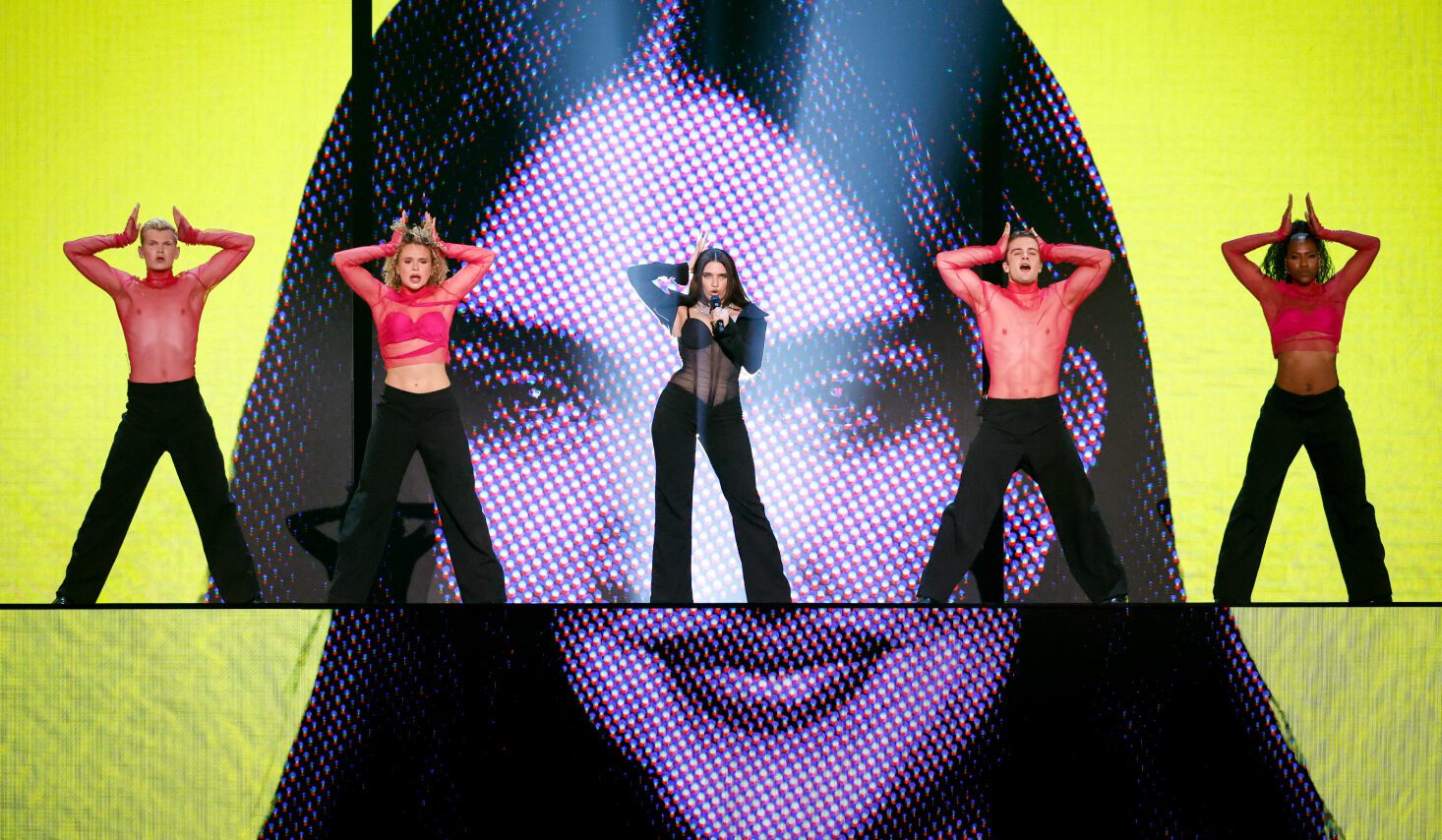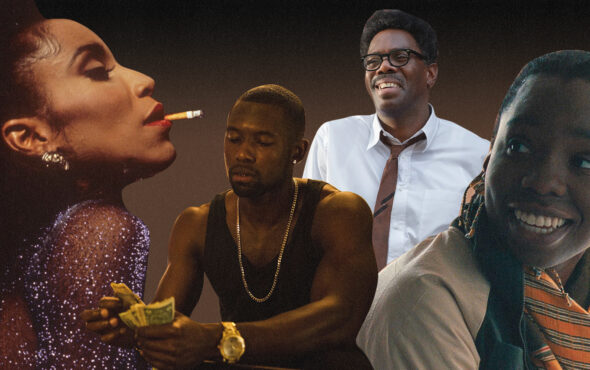
“As a gay man, it was exciting to see all the LGBTQ+ fans. It was almost like WorldPride came to Liverpool!” says Julio Himede. (He’s not wrong, it was a queer haven.) The director and founder of the New York City-based Yellow Studio – an “artistically-minded” firm that specialises in production design and creative/art direction for TV and live events – embarked on one of his most ambitious (and undeniably gayest/campest) projects to date this year with his team: the 67th Eurovision Song Contest.
The annual celebration of (quirky, outlandish) pop that unites communities across Europe, champions diversity and the LGBTQ+ community made its return to the UK for the first time in 25 years as a result of Russia’s ongoing invasion in 2022’s winning country, Ukraine. Julio and the team at Yellow Studio were responsible for developing the stage at the Liverpool Arena, a process he describes as “very intense” due to the technical and creative restraints that naturally come with an extravaganza on this scale: “Typically, on a show like Eurovision, you have a romantic period of design where you have three or four months exploring ideas. However, it was a special occasion because of the UK hosting the event on behalf of Ukraine, so the timeframe became shorter and shorter. We only had three weeks to come up with the concept and, once we pitched it, we ran with it. It was an unusual timeline!”
For obvious reasons, the theme for this year’s Eurovision was “United by Music”. While the theme plays a crucial part in how the staging develops, Julio says Eurovision’s main goal year-to-year is to tap into the “cultural aspect” of the competing countries. “We went down these rabbit holes of researching Ukraine’s cultural identities from embroidery to their musical instruments to their poetry and architecture,” he explains. “Similarly, when it came to the UK, we started highlighting what makes Liverpool. Apart from football, what is celebrated from a cultural perspective? Of course, Liverpool has a rich history of music, so that was a key factor for us in how to bring the musical elements together between both nations.”
Julio tells GAY TIMES that he and Yellow Studio, which consists of designers, producers and renderers, concluded that a “universal message of love” was apt. Following the Kalush Orchestra’s triumphant stint with their alternative hip-hop and folk track Stefania – which became the first rap song, as well as the first song sung entirely in Ukranian to win – the country was represented this year by Tvorchi’s Heart of Steel, which ultimately came in sixth place. Julio says: “We wanted to embrace Ukraine and give them a hug, almost. We came up with a concept of creating a design that was immersive with these archways that resembled two big arms as to say, ‘We welcome you.’”
London-born singer Mae Muller succeeded Sam Ryder as this year’s representative for the UK with her fan-favourite dance-pop anthem I Wrote A Song. While the track was unable to match Ryder’s unprecedented runner-up position, placing second to last, the performance gave the gays everything they could want from a pop diva: playful choreo, a squad of dancers and vibrant, conceptual CGI. With her hypnotic pop track Tattoo, in which she was “sandwiched” between two LED screens, Loreen historically became the first woman – and second person overall after Ireland’s Johnny Logan – to win the contest twice. When we ask Julio what the collaborative process looked like with his design firm and the artists and their team, as well as Eurovision themselves, he says: “We do Eurovision speed dating and we sit with each country for about 15 minutes and show them the design, and what the design can do. Some come prepared and have lots of creative documentation and references, from the lighting to the camerawork and overall visuals. Some of them needed our help!”
Typically, the vibe of a song and the lyrics can have a huge impact on the performance and staging. Surprisingly, Yellow Studio went in blind. Julio and the team worked on the concept in “October or November” and at this point, the acts competing in Eurovision weren’t yet known. “We have to focus on other aspects that enhance the performance. For example, we wanted to have the oval stage surrounded by a moshpit of fans because that gives a lot of wonderful energy to the performance. Bringing elements like that early in the process were important because we didn’t know who the performer was. Similarly, when we do other shows like the Grammy’s or the EMA’s or the VMA’s, we know that maybe Billie Eilish or Beyoncé might be performing, but we don’t know what the song might be until later on. It’s a bit of a guessing game!”


For opera productions or plays, Julio says the script is their “bible”. While they didn’t have a bible to reference, he explains that Eurovison’s rich, 67-year history meant that they could “study what the show requires”: “We have an idea of what the show and audience expects and the theatricality that we are required to deliver. A big factor, also, is for a four-hour long grand final. How do we keep developing a landscape or piece of architecture that is entertaining for the audience in the arena and the audience at home? We might not know the song, but we know that we can bring a lot of moving parts to the set that is entertaining for fans of Eurovision.”
As well as the short timeframe to complete their creative, Julio reveals that the most challenging aspect of the Eurovision experience boiled down to the transition between each performance. Yellow Studio has collaborated with various big-budget productions and award shows, where the transition period is usually “three-to-four minutes” as a result of commercial breaks. For Eurovision, however, the turnaround was – get this – 50 seconds. “As we’re designing the show, we have to be able to provide quick access to all the crew members that come in one way and to get rid of the creative that we’ve just seen perform and bring another new creative in at the same time. It was an army of people coming on stage to do these change-overs. It takes a lot of rehearsal and accuracy and extreme professionals to work out how to do it. There is no other show in the world that allows 50 seconds for all these massive change-overs. It was a remarkable achievement. It’s actually quite amusing to watch! I wish the audience at home could see it.”
Challenges aside, Julio describes his time at Eurovision as “a lot of fun” (duh!). Like he said, it was essentially a WorldPride with masses of queers stomping the streets with rainbow-flags, serving their finest Conchita Wurst and ABBA drag and chanting Loreen’s beloved 2012-winning anthem Euphoria. “It was so fascinating to see!” he says. “In the gay world, Eurovision is a significant cultural event through music and it’s a wonderful celebration that unites communities together. It was a festive, colourful event – without all the naughty parties!” Additionally, it was an opportunity for Yellow Studio to create new professional and personal relationships, “not just from the UK and Ukraine, but from a few other nations”: “The people we met, such as the BBC, welcomed and trusted us. Everybody was exceptionally professional and so ahead of the game. The quality of the work and the artistic quality was very impressive. It opened my eyes as to who and what else is out there. These collaborations will hopefully carry on.”
While hesitant to reveal what’s currently in the works for Yellow Studio – “I have a few NDAs!” Julio laughs – he teases a “diversity of work from small music productions” to a “big” festival later this year. With clients including Apple, Disney, MTV, Nike, Spotify and YouTube, among others, one thing is certain: the firm’s innovative, “story-driven” designs will continue to break creative boundaries.



